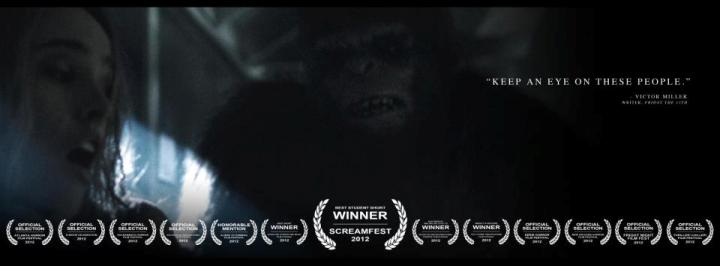
March 22, 2013

From Fangoria:
Q&A: Rob Himebaugh on his Bigfoot short, “EAGLEWALK”
Writer/director Rob Himebaugh’s thesis film EAGLEWALK has been stomping its way across North America in a momentum-gathering festival run, leaving a strong buzz in its wake. The film aims to revive the Sasquatch subgenre, taking an often playfully handled beastie and returning it to its sinister roots. This is what a Bigfoot movie should be. Frightening, taut, and fun.
I first encountered the 30 minute short film at the B-Movie Celebration in Indiana in the summer of 2012, and was incredibly impressed. Simply put, Himebaugh has managed to make Bigfoot scary, and he has accomplished the feat with a blend of nostalgia-drenched reverence for a summer camp setting, grounded characters that elevate the standard tropes, and a genuinely unsettling creature. EAGLEWALK is a brave and gorgeous movie that defies category and expertly walks the line between horror and the story of an emotional personal journey.
Himebaugh spent a few minutes chatting with FANGORIA about his award-winning short, his love for the cinematic work of Sean Cunningham and Tom Savini, and how the feature length version of EAGLEWALK is ready to roll, and ready to break even more new ground in a sadly neglected subgenre.
FANG: Why Bigfoot?
HIMEBAUGH: Because I was so obsessed with FRIDAY THE 13TH, I became a camp counselor. I wanted to be at Camp Crystal Lake. I sought out the most rustic camp on the East Coast. Somewhere inside of me, I wanted to tell a story that took place in a summer camp. I was trying to come up with a story for a horror film, something with a killer in the woods, but I didn’t want to get that close to FRIDAY THE 13TH. I wanted something that could exist in the woods, and Bigfoot was a logical alternative.
I had yet to see a good Bigfoot movie, so why not try to make Bigfoot scary again? Why not try to create this sense of place, in a location I am entranced by, with a creature people really haven’t seen that much in movies in a horrific sense.
FANG: How did you get things off the ground?
HIMEBAUGH: I started with the tagline, ‘Bigfoot attacks summer camp,’ and that was it. I started selling that idea to people, and it opened up all the doors I wanted to explore. I made the movie take place in the 80s, more or less successfully, and I wanted to play with all the stereotypes from that time, but put them on their heads. My intentions were to take the material and elevate and give people a movie monster that they’ve not necessarily seen before.
Alone in the woods, in dilapidated buildings, with this locomotive of a monster that can just break down the door? That is one of the scariest situations you could possibly be in.
As much as it is a horror film, it is a valentine to childhood and innocence lost. I think Elliot’s arc and turn into darkness, as limited as it is in a short film, parallels the story of the camp and how it closed and has been abandoned. He and the camp are both experiencing rebirth.
FANG: Let’s talk about the Bigfoot suit…
HIMEBAUGH: It is hard to make a man in a suit work. Our budget wasn’t really big enough to create a suit that did all things I wanted, like move fast, and where it doesn’t look like a cone head. It’s tricky because we want to reinvent Bigfoot, but not reinvent him to the point where he is unrecognizable and becomes just some crazy wood-dwelling demon.
We auditioned body types. I had guys coming in and I’d play some music, and they would act for me, moving their body. We had short and stalky, really tall, and at a certain point you reach a crossroads. The classic Bigfoot look is a big guy with a lot of muscles with a lumbering quality. We wanted him to be as tall and broad shouldered as possible. I think being big, it would be unstoppable in a way that a smaller version wouldn’t be.
When we were looking at the feet, we studied actual Bigfoot prints. My makeup artist made a mold that was the exact dimensions and shape of these footprints that you always see in magazines. His feet are actually Bigfoot’s legendary footprints.
Again, since we had a limited budget, we had to compromise on the vision, and our makeup artists did a great job with the money we had. You can design the suit as good as you want to, but the other half of it is how you shoot it. That is how you sell any monster.
I especially like the scenes in the shower where he is cloaked in darkness. Then there is the waterfront scene, which was shot in broad daylight and when the actor would move, you could see the top of their head wiggling and stuff. At that point we’ve played our horror and suspense card, and at this point it is no longer about the horror of the film. If the audience does see a man in a suit, that’s okay, because at this point it isn’t about Bigfoot anymore. It is about Elliot’s retribution.
About Craig Woolheater
Co-founder of Cryptomundo in 2005.
I have appeared in or contributed to the following TV programs, documentaries and films:
OLN's Mysterious Encounters: "Caddo Critter", Southern Fried Bigfoot, Travel Channel's Weird Travels: "Bigfoot", History Channel's MonsterQuest: "Swamp Stalker", The Wild Man of the Navidad, Destination America's Monsters and Mysteries in America: Texas Terror - Lake Worth Monster, Animal Planet's Finding Bigfoot: Return to Boggy Creek and Beast of the Bayou.
Filed under Bigfoot, Bigfoot Report, Cinema News, Cryptid Cinema, CryptoConsumerism, Cryptofiction, Cryptozoology, Pop Culture, Sasquatch, Social Media